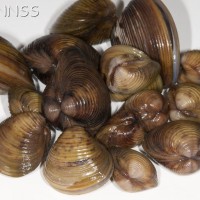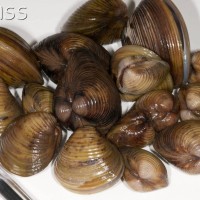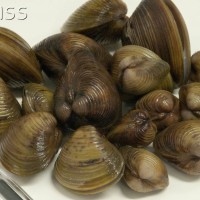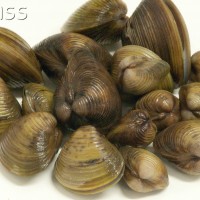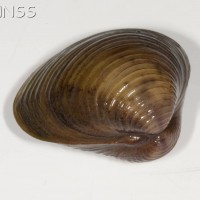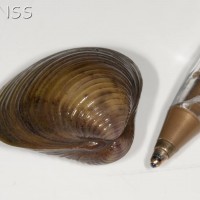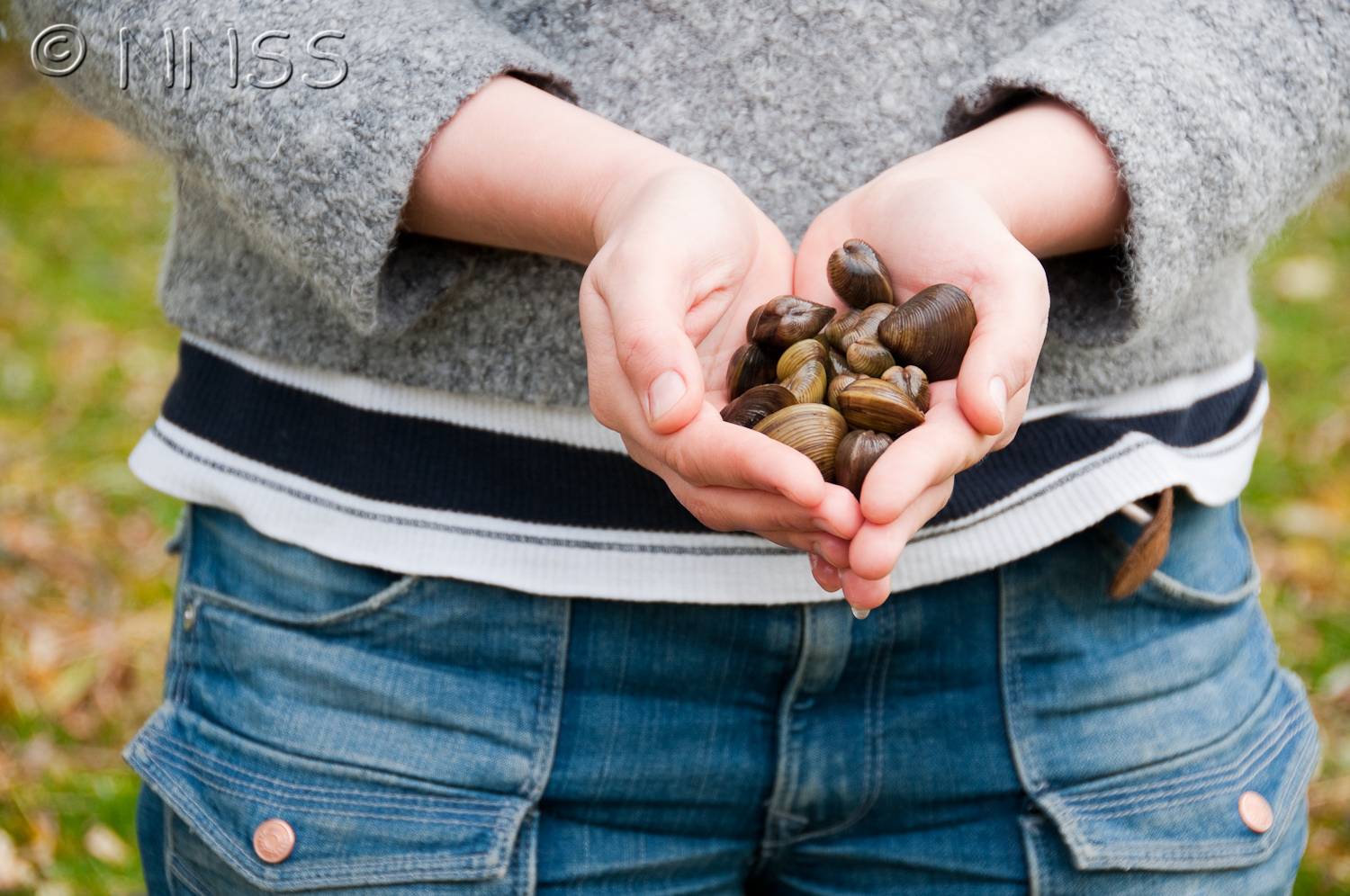
Asiatic Clam - Corbicula fluminea
Expand and collapse the sections below by clicking on the title or + / - icons.
Short description of Corbicula fluminea, Asiatic Clam
The Asiatic clam is a bivalve with a yellow-brown, globular shell of rounded to triangular outline and usually <30 mm (max. 45 mm) length. The shells are sculptured with prominent, raised, regular concentric ribs.
Impact summary: Corbicula fluminea, Asiatic Clam
It has become a major pest in Europe and North America because of its high reproductive output, rapid growth rate and great powers of dispersal. It can affect all components of the freshwater ecosystem, causing serious ecological and economic problems.
Habitat summary: Corbicula fluminea, Asiatic Clam
In the sediments of oligotrophic to eutrophic streams, rivers, lakes, and irrigation and drainage cuts. It is common on oxygenated muddy to sandy sediments, but also occurring among gravel and cobbles.
Overview table
| Environment | Freshwater |
|---|---|
| Species status | Non-Native |
| Native range | Africa, Russian Far East, China, Australia, North Korea, Russia Central, Russia East, Russia North, Russia Northwest, Russia South |
| Functional type | Filter-feeder |
| Status in England | Non-Native |
| Status in Scotland | |
| Status in Wales | Non-Native |
| Location of first record | River Chet (Norfolk Broads) |
| Date of first record | 1998 |
Origin
Native to Southern and Eastern Asia (eastern Russia, Thailand, Philippines, China, Taiwan, Korea, and Japan), Australia, and Africa.
First Record
1998 in the River Chet on the Norfolk Broads; probably arrived in Norfolk in 1997
Pathway and Method
Introduction pathway into GB unknown, but introduction from USA into Europe via ballast water
Species Status
First recorded in North America in 1924, it was introduced into South America and southwest Europe in the 1970searly 1980s. After its arrival in Portugal, it spread eastwards and is now widespread across Europe. After introduction to Britain in the late 1990s to the Norfolk Broads, by 2002, it had already colonised all of the major rivers of The Broads drainage system, and in places densities of over 2500 individualsm2 were recorded. Now it can be found in many rivers in this area, as well as in the Thames and the Great Ouse system, and is continuing its spread.
Dispersal Mechanisms
Asian clam larvae (pediveligers) produce a byssus causing it to be dragged by water currents, and juveniles and adults may produce tacky mucus strings that can also result in dispersal. It may also be spread by birds and mammals, but humans are the main actors in this clam’s spread. Thus, it can be moved entangled in macrophytes and with overland boat transmissions, and is used in ornamental ponds, aquaria and as angling bait. The species can rapidly recolonise areas following purges.
Reproduction
It is a self fertile species and thus, a single individual can be sufficient to develop a new population. It reproduces at ~15 °C from about 6-10 mm and three months of age with more than one brood a year. Brooded, non-swimming pediveliger larvae are released from late spring to autumn.
Known Predators/Herbivores
Small individuals are consumed by fish.
Resistant Stages
Tolerant of aerial exposure for weeks.
Habitat Occupied in GB
Habitats range from shallow, essentially lentic environments to relatively wide, deep, flowing rivers and associated channels. The species occupies a range of substrates, preferring sand and gravel to mud. In the River Chet, highest densities are found within the central channels, which is the converse of native mussel distributions at the sites. It tolerates 2-34°C and can survive several weeks in water of 0°C, and can also live in salinities to ~5‰ with short periods of up to 14psu. It is intolerant of areas with high nutrient loads andor low oxygen levels.
Present on almost all continents and invasive in North America, South America and Europe. Widespread and common across almost all Europe. In GB, recorded from Southeast England, and in particular the Norfolk Broads drainage system, the River Thames and the Great Ouse system.
Environmental Impact
The combination of this species’ high filtration rates, ability to produce large quantities of pseudofaeces and attain enormous population densities (> 2500 individualsm2) can alter ecosystem dynamics. For example, production of pseudofaeces increases sedimentation and changes substrate composition. It can sequester an enormous portion of the carbon available for benthic production, thereby altering ecosystem functioning. It also competes with native filter feeding bivalves and snails feeding on organics in sediments. Accumulations of shells can block water intakes and irrigation channels.
Health and Social Impact
None known.
Economic Impact
Capable of reducing flows in drainage and abstraction pipes in low-flow areas and during periods of low peak usage. Shells can clog the narrow gauge piping of condensers and heat exchangers of power plants. High density occurrences in gravels make some building materials worthless.
Identification
Killeen, I., Aldridge, D.C. & Oliver, G. (2004) Freshwater Bivalves of Britain and Ireland. Field Studies Council.
Biology, ecology, spread, vectors
Aldridge, D.C. & Muller, S.J. (2001) The Asiatic clam, Corbicula fluminea, in Britain: current status and potential impacts. Journal of Conchology, 37, 177-183.
Araujo, R., Moreno, D. & Ramos, M.A. (1993) The Asiatic clam Corbicula fluminea (Mueller,1774) (Bivalvia: Corbiculidae) in Europe. American Malacological Bulletin, 10, 39-49.
Elliott, P. & Ermgassen, P.S.E.z. (2008) The Asian clam (Corbicula fluminea) in the River Thames, London, England. Aquatic Invasions, 3, 54-60.
Howlett, D. & Baker, R. (1999) Corbicula fluminea (Muller): New to UK. Journal of Conchology, 36, 83-83.
McMahon, R. (1983) Ecology of an invasive pest bivalve, Corbicula. The Mollusca. Ecology (ed W. Russell-Hunter), pp. 505-561. Academic Press, New York.
Management and impact
Hakenkamp, C.C., Ribblett, S.G., Palmer, M.A., Swan, C.M., Reid, J.W. & Goodison, M.R. (2001) The impact of an introduced bivalve (Corbicula fluminea) on the benthos of a sandy stream. Freshwater Biology, 46, 491-501.
Sousa, R., Nogueira, A.J.A., Gaspar, M.B., Antunes, C. & Guilhermino, L. (2008) Growth and extremely high production of the non-indigenous invasive species Corbicula fluminea (Muller, 1774): Possible implications for ecosystem functioning. Estuarine Coastal and Shelf Science, 80, 289-295.
General
Killeen, I., Aldridge, D.C. & Oliver, G. (2004) Freshwater Bivalves of Britain and Ireland. Field Studies Council.
Spotted this species?
Distribution map
View the Distribution map for Asiatic Clam, Corbicula fluminea from NBN Atlas
Risk assessment
Risk assessment for Corbicula fluminea. See a full list of non-native species Risk assessments.


